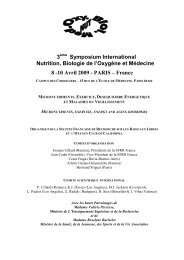oxidants and antioxidants in biology - Oxygen Club of California
oxidants and antioxidants in biology - Oxygen Club of California
oxidants and antioxidants in biology - Oxygen Club of California
Create successful ePaper yourself
Turn your PDF publications into a flip-book with our unique Google optimized e-Paper software.
Mitochondrial regulation <strong>of</strong> apoptotic cell death<br />
S. ORRENIUS<br />
Karol<strong>in</strong>ska Institutet, Stockholm, Sweden.<br />
Although it has long been known that impairment <strong>of</strong> mitochondrial<br />
function may lead to ATP depletion <strong>and</strong> necrotic cell<br />
death, recent work has revealed that these organelles also play an<br />
important role <strong>in</strong> the overall regulation <strong>of</strong> apoptotic cell death by<br />
mechanisms which have been conserved through evolution. Thus, it<br />
seems that a number <strong>of</strong> death triggers target the mitochondria <strong>and</strong><br />
stimulate their release <strong>of</strong> cytochrome c <strong>and</strong> other pro-apoptotic<br />
prote<strong>in</strong>s, which can trigger caspase activation <strong>and</strong> other parts <strong>of</strong> the<br />
apoptotic process. Cytochrome c release is governed by the Bcl-2<br />
family <strong>of</strong> prote<strong>in</strong>s, whereas subsequent caspase activation is<br />
modulated by other prote<strong>in</strong>s, <strong>in</strong>clud<strong>in</strong>g <strong>in</strong>hibitor <strong>of</strong> apoptosis prote<strong>in</strong>s<br />
(IAPs) <strong>and</strong> heat shock prote<strong>in</strong>s. Recent f<strong>in</strong>d<strong>in</strong>gs <strong>in</strong>dicate that<br />
cytochrome c extrusion occurs by a two-step process, which is <strong>in</strong>itiated<br />
by a disruption <strong>of</strong> the association <strong>of</strong> this prote<strong>in</strong> with cardiolip<strong>in</strong>,<br />
the phospholipid that anchors it to the outer surface <strong>of</strong> the<br />
<strong>in</strong>ner mitochondrial membrane. Release <strong>of</strong> the solubilized pool <strong>of</strong><br />
cytochrome c <strong>in</strong>to the cytosol may then occur by pore formation<br />
mediated by pro-apoptotic Bcl-2 family prote<strong>in</strong>s, notably Bax <strong>and</strong><br />
Bak, or by mitochondrial permeability transition followed by matrix<br />
swell<strong>in</strong>g <strong>and</strong> rupture <strong>of</strong> the outer mitochondrial membrane. Recent<br />
evidence suggests that cytochrome c release dur<strong>in</strong>g apoptosis<br />
may <strong>in</strong> fact <strong>in</strong>volve a comb<strong>in</strong>ation <strong>of</strong> these two mechanisms. Taken<br />
together, these f<strong>in</strong>d<strong>in</strong>gs have placed the mitochondria <strong>in</strong> the focus<br />
<strong>of</strong> apoptosis research <strong>and</strong> further underl<strong>in</strong>ed the important function<br />
<strong>of</strong> these organelles <strong>in</strong> cell life <strong>and</strong> death.<br />
32








